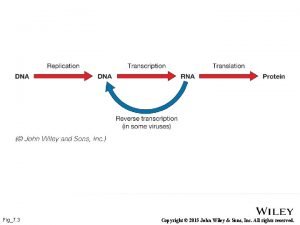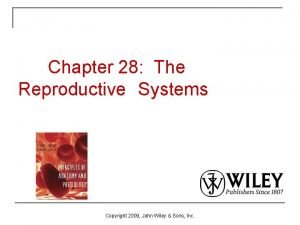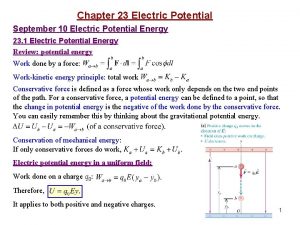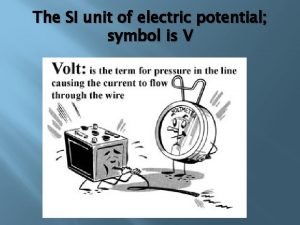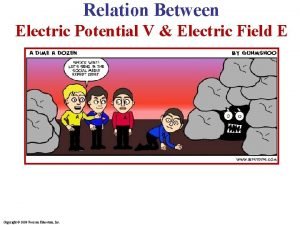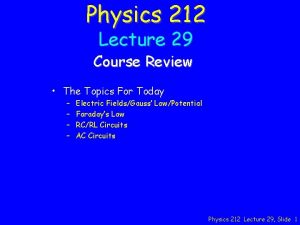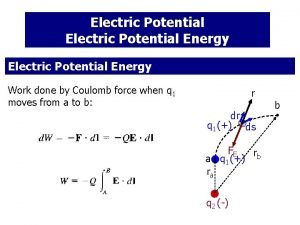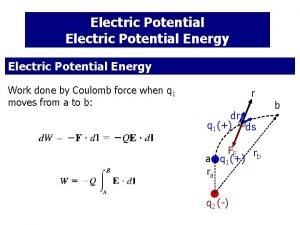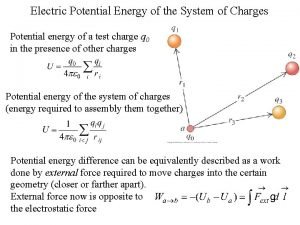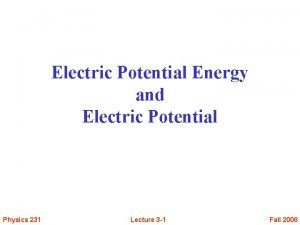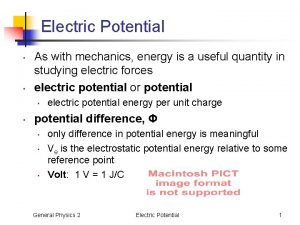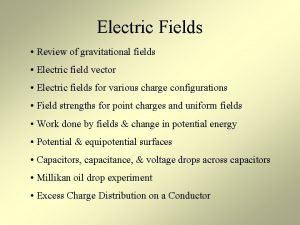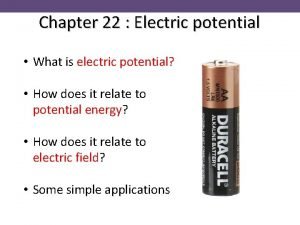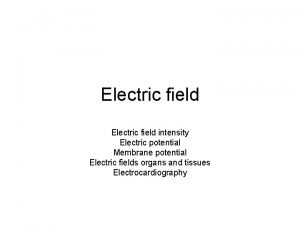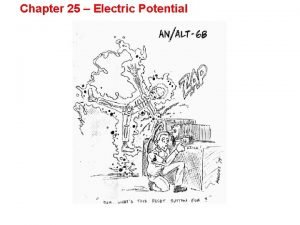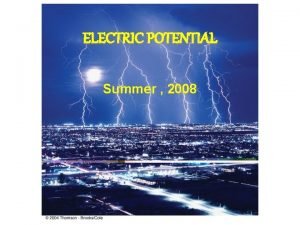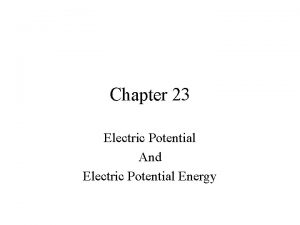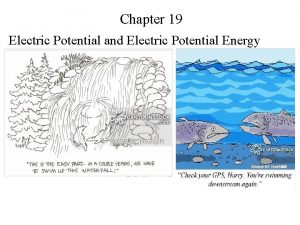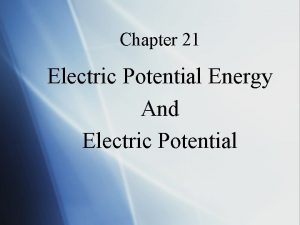Chapter 24 Electric Potential Copyright 2014 John Wiley





















































- Slides: 53

Chapter 24 Electric Potential Copyright © 2014 John Wiley & Sons, Inc. All rights reserved.

24 -1 Electric Potential Learning Objectives 24. 01 Identify that the electric force is conservative and thus has an associated potential energy. relationship between the object’s electric potential V at that point, the particle’s charge q, and the potential energy U of the particle– object system. 24. 02 Identify that at every point in a charged object’s electric field, 24. 04 Convert energies between units of joules and electron-volts. the object sets up an electric potential V, which is a scalar 24. 05 If a charged particle moves quantity that can be positive or from an initial point to a final point negative depending on the sign in an electric field, apply the of the object’s charge. relationships between the change 24. 03 For a charged particle ΔV in the potential, the particle’s placed at a point in an object’s charge q, the change ΔU in the electric field, apply the potential energy, and the work W done by the electric force. © 2014 John Wiley & Sons, Inc. All rights reserved.

24 -1 Electric Potential Learning Objectives 24. 06 If a charged particle moves between two given points in the electric field of a charged object, identify that the amount of work done by the electric force is path independent. 24. 07 If a charged particle moves through a change ΔV in electric potential without an applied force acting on it, relate ΔV and the change ΔK in the particle’s kinetic energy. 24. 08 If a charged particle moves through a change ΔV in electric potential while an applied force acts on it, relate ΔV, the change ΔK in the particle’s kinetic energy, and the work Wapp done by the applied force. © 2014 John Wiley & Sons, Inc. All rights reserved.

24 -1 Electric Potential The electric potential V at a point P in the electric field of a charged object is where W∞ is the work that would be done by the electric force on a positive test charge q 0 were it brought from an infinite distance to P, and U is the electric potential energy that would then be stored in the test charge–object system. If a particle with charge q is placed at a point where the electric potential of a charged object is V, the electric potential energy U of the particle–object system is (a) A test charge has been brought in from infinity to point P in the electric field of the rod. (b) We define an electric potential V at P based on the potential energy of the configuration in (a). © 2014 John Wiley & Sons, Inc. All rights reserved.

24 -1 Electric Potential Change in Electric Potential. If the particle moves through a potential difference ΔV, the change in the electric potential energy is Work by the Field. The work W done by the electric force as the particle moves from i to f: Conservation of Energy. If a particle moves through a change ΔV in electric potential without an applied force acting on it, applying the conservation of mechanical energy gives the change in kinetic energy as Work by an Applied Force. If some force in addition to the electric force acts on the particle, we account for that work © 2014 John Wiley & Sons, Inc. All rights reserved.







24 -2 Equipotential Surfaces and the Electric Field Learning Objectives 24. 09 Identify an equipotential surface and describe how it is related to the direction of the associated electric field. 24. 10 Given an electric field as a function of position, calculate the change in potential ΔV from an initial point to a final point by choosing a path between the points and integrating the dot product of the field E and a length element ds along the path. 24. 11 For a uniform electric field, relate the field magnitude E and the separation Δx and potential difference ΔV between adjacent equipotential lines. 24. 12 Given a graph of electric field E versus position along an axis, calculate the change in potential ΔV from an initial point to a final point by graphical integration. 24. 13 Explain the use of a zeropotential location. © 2014 John Wiley & Sons, Inc. All rights reserved.

24 -2 Equipotential Surfaces and the Electric Field Adjacent points that have the same electric potential form an equipotential surface, which can be either an imaginary surface or a real, physical surface. Figure shows a family of equipotential surfaces associated with the electric field due to some distribution of charges. The work done by the electric field on a charged particle as the particle moves from one end to the other of paths I and II is zero because each of these paths begins and ends on the same equipotential surface and thus there is no net change in potential. The work done as the charged particle moves from one end to the other of paths III and IV is not zero but has the same value for both these paths because the initial and final potentials are identical for the two paths; that is, paths III and IV connect the same pair of equipotential surfaces. © 2014 John Wiley & Sons, Inc. All rights reserved.

24 -2 Equipotential Surfaces and the Electric Field The electric potential difference between two points i and f is where the integral is taken over any path connecting the points. If the integration is difficult along any particular path, we can choose a different path along which the integration might be easier. If we choose Vi = 0, we have, for the potential at a A test charge q 0 moves from particular point, point i to point f along the path In a uniform field of magnitude E, the change in potential from a higher equipotential surface to a lower one, separated by distance Δx, is © 2014 John Wiley & Sons, Inc. All rights reserved. shown in a non-uniform electric field. During a displacement ds, an electric force q 0 E acts on the test charge. This force points in the direction of the field line at the location of the test charge.






24 -3 Potential due to a Charged Particle Learning Objectives 24. 14 For a given point in the electric field of a charged particle, apply the relationship between the electric potential V, the charge of the particle q, and the distance r from the particle. symmetric charge distribution, calculate the electric potential as if all the charge is concentrated as a particle at the center of the sphere. 24. 17 Calculate the net potential at any given point due to 24. 15 Identify the correlation several charged particles, between the algebraic signs of identifying that algebraic the potential set up by a addition is used, not vector particle and the charge of the addition. particle. 24. 18 Draw equipotential lines for 24. 16 For points outside or on a charged particle. the surface of a spherically © 2014 John Wiley & Sons, Inc. All rights reserved.

24 -3 Potential due to a Charged Particle We know that the electric potential In this figure the particle difference between two points i and f is with positive charge q For radial path The magnitude of the electric field at the site of the test charge produces an electric field E and an electric potential V at point P. We find the potential by moving a test charge q 0 from P to infinity. The test charge is shown at distance r from the particle, during differential displacement ds. We set Vf =0 (at ∞) and Vi =V (at R) Solving for V and switching R to r, we get as the electric potential V due to a particle of charge q at any radial distance r from the particle. © 2014 John Wiley & Sons, Inc. All rights reserved.

24 -3 Potential due to a Charged Particle Potential due to a group of Charged Particles The potential due to a collection of charged particles is Thus, the potential is the algebraic sum of the individual potentials, with no consideration of directions. Answer: Same net potential (a)=(b)=(c) © 2014 John Wiley & Sons, Inc. All rights reserved.





24 -4 Potential due to a Electric Dipole Learning Objectives 24. 19 Calculate the potential V at any given point due to an electric dipole, in terms of the magnitude p of the dipole moment or the product of the charge separation d and the magnitude q of either charge. 24. 20 For an electric dipole, identify the locations of positive potential, negative potential, and zero potential. 24. 21 Compare the decrease in potential with increasing distance for a single charged particle and an electric dipole. © 2014 John Wiley & Sons, Inc. All rights reserved.

24 -4 Potential due to a Electric Dipole The net potential at P is given by We can approximate the two lines to P as being parallel and their length difference as being the leg of a right triangle with hypotenuse d (Fig. b). Also, that difference is so small that the product of the lengths is approximately r 2. (a) Point P is a distance r from the midpoint O of a dipole. The line OP We can approximate V to be makes an angle θ with the dipole axis. where θ is measured from the dipole axis as shown in Fig. a. And since p=qd, we have (b) If P is far from the dipole, the lines of lengths r(+) and r(-) are approximately parallel to the line of length r, and the dashed black line is approximately perpendicular to the line of length r(-). © 2014 John Wiley & Sons, Inc. All rights reserved.



24 -5 Potential due to a Continuous Charge Distribution Learning Objectives 24. 22 For charge that is distributed uniformly along a line or over a surface, find the net potential at a given point by splitting the distribution up into charge elements and summing (by integration) the potential due to each one. © 2014 John Wiley & Sons, Inc. All rights reserved.

24 -5 Potential due to a Continuous Charge Distribution For a continuous distribution of charge (over an extended object), the potential is found by (1) dividing the distribution into charge elements dq that can be treated as particles and then (2) summing the potential due to each element by integrating over the full distribution: We now examine two continuous charge distributions, a line and a disk. © 2014 John Wiley & Sons, Inc. All rights reserved.

24 -5 Potential due to a Continuous Charge Distribution Line of Charge Fig. a has a thin conducting rod of length L. As shown in fig. b the element of the rod has a differential charge of This element produces an electric potential d. V at point P (fig c) given by We now find the total potential V produced by the rod at point P by integrating d. V along the length of the rod, from x = 0 to x = L (Figs. d and e) Simplified to, © 2014 John Wiley & Sons, Inc. All rights reserved.

24 -5 Potential due to a Continuous Charge Distribution Charged Disk In figure, consider a differential element consisting of a flat ring of radius R’ and radial width d. R’. Its charge has magnitude in which (2πR’)(d. R’) is the upper surface area of the ring. The contribution of this ring to the electric potential at P is We find the net potential at P by adding (via integration) A plastic disk of radius R, charged the contributions of all the rings from R’=0 to R’=R: Note that the variable in the second integral is R’ and not z on its top surface to a uniform surface charge density σ. We wish to find the potential V at point P on the central axis of the disk. © 2014 John Wiley & Sons, Inc. All rights reserved.



24 -6 Calculating the Field from the Potential Learning Objectives 24. 23 Given an electric potential as a function of position along an axis, find the electric field along that axis. 24 Given a graph of electric potential versus position along an axis, determine the electric field along the axis. 24. 25 For a uniform electric field, relate the field magnitude E. and the separation Δx and potential difference ΔV between adjacent equipotential lines. 24. 26 Relate the direction of the electric field and the directions in which the potential decreases and increases. © 2014 John Wiley & Sons, Inc. All rights reserved.

24 -6 Calculating the Field from the Potential Suppose that a positive test charge q 0 moves through a displacement ds from one equipotential surface to the adjacent surface. The work the electric field does on the test charge during the move is – q 0 d. V. On the other hand the work done by the electric field may also be written as the scalar product (q 0 E) ds. Equating these two expressions for the work yields or, Since E cosθ is the component of E in the direction of ds, we get, A test charge q 0 moves a distance ds from one equipotential surface to another. (The separation between the surfaces has been exaggerated for clarity. ) The displacement ds makes an angle θ with the direction of the electric field E. © 2014 John Wiley & Sons, Inc. All rights reserved.



24 -7 Electric Potential Energy of a System of Charged Particles Learning Objectives 24. 27 Identify that the total potential energy of a system of charged particles is equal to the work an applied force must do to assemble the system, starting with the particles infinitely far apart. 24. 28 Calculate the potential energy of a pair of charged particles. 24. 29 Identify that if a system has more than two charged particles, then the system’s total potential energy is equal to the sum of the potential energies of every pair of the particles. 24. 30 Apply the principle of the conservation of mechanical energy to a system of charged particles. 24. 31 Calculate the escape speed of a charged particle from a system of charged particles (the minimum initial speed required to move infinitely far from the system). © 2014 John Wiley & Sons, Inc. All rights reserved.

24 -7 Electric Potential Energy of a System of Charged Particles The electric potential energy of a system of charged particles is equal to the work needed to assemble the system with the particles initially at rest and infinitely distant from each other. For two particles at separation r, Two charges held a fixed distance r apart. Three charges are fixed at the vertices of an equilateral triangle. What is the electric potential energy of the system? © 2014 John Wiley & Sons, Inc. All rights reserved.




24 -8 Potential of a Charged Isolated Conductor Learning Objectives 24. 32 Identify that an excess charge placed on an isolated conductor (or connected isolated conductors) will distribute itself on the surface of the conductor so that all points of the conductor come to the same potential. 24. 33 For an isolated spherical conducting shell, sketch graphs of the potential and the electric field magnitude versus distance from the center, both inside and outside the shell. 24. 34 For an isolated spherical conducting shell, identify that internally the electric field is zero and the electric potential has the same value as the surface and that externally the electric field and the electric potential have values as though all of the shell’s charge is concentrated as a particle at its center. © 2014 John Wiley & Sons, Inc. All rights reserved.

24 -8 Potential of a Charged Isolated Conductor Learning Objectives (Contd. ) 24. 35 For an isolated cylindrical conducting shell, identify that internally the electric field is zero and the electric potential has the same value as the surface and that externally the electric field and the electric potential have values as though all of the cylinder’s charge is concentrated as a line of charge on the central axis. © 2014 John Wiley & Sons, Inc. All rights reserved.

24 -8 Potential of a Charged Isolated Conductor (a) A plot of V(r) both inside and outside a charged spherical shell of radius 1. 0 m. (a) A plot of E(r) for the same shell. It is wise to enclose yourself in a cavity inside a conducting shell, where the electric field is guaranteed to be zero. A car (unless it is a convertible or made with a plastic body) is almost ideal. © 2014 John Wiley & Sons, Inc. All rights reserved.




24 Summary Mechanical Energy Electric Potential • The electric potential V at point P in the electric field of a charged object: Eq. 24 -2 Electric Potential Energy • Electric potential energy U of the particle-object system: Eq. 24 -3 • If the particle moves through potential ΔV: Eq. 24 -4 • Applying the conservation of mechanical energy gives the change in kinetic energy: Eq. 24 -9 • In case of an applied force in a particle Eq. 24 -11 • In a special case when ΔK=0: Eq. 24 -12 Finding V from E • The electric potential difference between two point I and f is: Eq. 24 -18 © 2014 John Wiley & Sons, Inc. All rights reserved.

24 Summary Potential due to a Charged Particle • due to a single charged particle at a distance r from that particle : Potential due to a Continuous Charge Distribution • For a continuous distribution of charge: Eq. 24 -26 • due to a collection of charged particles Eq. 24 -27 Potential due to an Electric Dipole • The electric potential of the dipole is Eq. 24 -32 Calculating E from V • The component of E in any direction is: Eq. 24 -40 Electric Potential Energy of a System of Charged Particle • For two particles at separation r: Eq. 24 -30 © 2014 John Wiley & Sons, Inc. All rights reserved. Eq. 24 -46
 Electrostatic potential energy definition
Electrostatic potential energy definition Equipotential lines
Equipotential lines Electric potential unit
Electric potential unit Electric potential inside non conducting sphere
Electric potential inside non conducting sphere Potential due to dipole
Potential due to dipole Expression for electric potential difference
Expression for electric potential difference Potential electric energy formula
Potential electric energy formula Electric potential and electric field
Electric potential and electric field John wiley & sons
John wiley & sons John wiley & sons
John wiley & sons John wiley
John wiley Copyright search
Copyright search Klein organic chemistry 2nd edition
Klein organic chemistry 2nd edition John wiley
John wiley Continuous vs saltatory conduction
Continuous vs saltatory conduction Conceptual physics chapter 33
Conceptual physics chapter 33 Chapter 23 electric potential
Chapter 23 electric potential Electrostatic potential
Electrostatic potential Chapter 21 electric charge and electric field
Chapter 21 electric charge and electric field Chapter 21 electric charge and electric field
Chapter 21 electric charge and electric field K constant unit
K constant unit Chapter 21 electric charge and electric field
Chapter 21 electric charge and electric field Copyright 2014 pearson education inc
Copyright 2014 pearson education inc How to find pressure potential
How to find pressure potential Flaccid turgid and plasmolysis
Flaccid turgid and plasmolysis Water potential equation
Water potential equation Graded potential vs action potential
Graded potential vs action potential Graded potential vs action potential
Graded potential vs action potential Graded potential vs action potential
Graded potential vs action potential Graded potential vs action potential
Graded potential vs action potential Graded vs action potential
Graded vs action potential Osmotic potential vs water potential
Osmotic potential vs water potential Sources of biopotential
Sources of biopotential Hypopolarization
Hypopolarization Succinylcholine dose
Succinylcholine dose Axon hillock
Axon hillock Action potential resting potential
Action potential resting potential Difference between sales potential and market potential
Difference between sales potential and market potential Symbol for electric potential
Symbol for electric potential Relation between electric field and potential energy
Relation between electric field and potential energy Electric potential inside non conducting sphere
Electric potential inside non conducting sphere Contoh soal momen dipol
Contoh soal momen dipol Gravitational potential isolines
Gravitational potential isolines Electric potential difference
Electric potential difference Si unit of electric potential
Si unit of electric potential Is potential energy the integral of force
Is potential energy the integral of force Work done by coulomb force
Work done by coulomb force Electric potential units
Electric potential units Potential gradient definition
Potential gradient definition Electrical potential energy
Electrical potential energy Electric potential analogy
Electric potential analogy Si unit of electric potential
Si unit of electric potential Which potential graph describes this electric field
Which potential graph describes this electric field Electric potential analogy
Electric potential analogy








